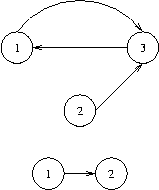The Bottom of a Graph
阿新 • • 發佈:2017-06-18
ive limit rtai assume ted can hab spa mean poj——The Bottom of a Graph
Let n be a positive integer, and let p=(e1,...,en) be a sequence of length n of edges ei∈E such that ei=(vi,vi+1) for a sequence of vertices (v1,...,vn+1). Then p is called a path from vertex v1
Here are some new definitions. A node v in a graph G=(V,E) is called a sink, if for every node w in G that is reachable from v, v is also reachable from w. The bottom of a graph is the subset of all nodes that are sinks, i.e.,bottom(G)={v∈V|∀w∈V:(v→w)⇒(w→v)} 
如果v點能夠到的點,反過來能夠到達v點,則稱這個點為sink點,輸出所有的sink點 思路: 我們這樣想:對於一對點如果他們能夠相互到達,那麽他們在縮點是一定能縮成一個點,這樣我們剩下的就是不能縮點的情況了。 也就是說我們縮完點後就剩下兩種情況:1.這個點連向其它的點但是那個點不連向他 2.這個點不連向任意點 在這兩種情況中第二種情況對於sink點的要求是顯然成立的。而第一種情況是不成立的,因為這種情況一定是另一個點不連向這個點的,也就是說她是單向的。 (最開始沒明白的地方。。。) 我們為何要在判斷一個點的出度為0時循環到n?? 因為我們把這些點縮成一個點,這樣我們在進行判斷每一個點的時候有兩種選擇: 1.我們先將出度為零的強連通分量記錄在一個數組中。然後再用一個雙重循環來判斷一下那個點在這個數組中 2.我們用一個一重循環,循環到n,判斷這個點所屬的強連通分量縮點後對應的點的出度是否為0,若是0,用一個數組將其儲存下來。 排序 輸出這個數組內的元素 代碼:
| Time Limit: 3000MS | Memory Limit: 65536K | |
| Total Submissions: 11044 | Accepted: 4542 |
Description
We will use the following (standard) definitions from graph theory. Let V be a nonempty and finite set, its elements being called vertices (or nodes). Let ELet n be a positive integer, and let p=(e1,...,en) be a sequence of length n of edges ei∈E such that ei=(vi,vi+1) for a sequence of vertices (v1,...,vn+1). Then p is called a path from vertex v1
Here are some new definitions. A node v in a graph G=(V,E) is called a sink, if for every node w in G that is reachable from v, v is also reachable from w. The bottom of a graph is the subset of all nodes that are sinks, i.e.,bottom(G)={v∈V|∀w∈V:(v→w)⇒(w→v)}
Input
The input contains several test cases, each of which corresponds to a directed graph G. Each test case starts with an integer number v, denoting the number of vertices of G=(V,E), where the vertices will be identified by the integer numbers in the set V={1,...,v}. You may assume that 1<=v<=5000. That is followed by a non-negative integer e and, thereafter, e pairs of vertex identifiers v1,w1,...,ve,we with the meaning that (vi,wi)∈E. There are no edges other than specified by these pairs. The last test case is followed by a zero.Output
For each test case output the bottom of the specified graph on a single line. To this end, print the numbers of all nodes that are sinks in sorted order separated by a single space character. If the bottom is empty, print an empty line.
Sample Input
3 3
1 3 2 3 3 1
2 1
1 2
0
Sample Output
1 3
2
Source
Ulm Local 2003定義:點v是匯點須滿足 --- 對圖中任意點u,若v可以到達u則必有u到v的路徑;若v不可以到達u,則u到v的路徑可有可無。
題目大意:如果v點能夠到的點,反過來能夠到達v點,則稱這個點為sink點,輸出所有的sink點 思路: 我們這樣想:對於一對點如果他們能夠相互到達,那麽他們在縮點是一定能縮成一個點,這樣我們剩下的就是不能縮點的情況了。 也就是說我們縮完點後就剩下兩種情況:1.這個點連向其它的點但是那個點不連向他 2.這個點不連向任意點 在這兩種情況中第二種情況對於sink點的要求是顯然成立的。而第一種情況是不成立的,因為這種情況一定是另一個點不連向這個點的,也就是說她是單向的。 (最開始沒明白的地方。。。) 我們為何要在判斷一個點的出度為0時循環到n?? 因為我們把這些點縮成一個點,這樣我們在進行判斷每一個點的時候有兩種選擇: 1.我們先將出度為零的強連通分量記錄在一個數組中。然後再用一個雙重循環來判斷一下那個點在這個數組中 2.我們用一個一重循環,循環到n,判斷這個點所屬的強連通分量縮點後對應的點的出度是否為0,若是0,用一個數組將其儲存下來。 排序 輸出這個數組內的元素 代碼:
#include<cstdio> #include<cstdlib> #include<cstring> #include<iostream> #include<algorithm> #define N 10000 using namespace std; bool vis[N]; int n,m,x,y,sum,tim,tot,top; int out[N],dfn[N],low[N],ans[N],head[N],stack[N],belong[N],point[N]; inline int read() { int x=0,f=1;char ch=getchar(); while(ch<‘0‘||ch>‘9‘) {if(ch==‘-‘) f=-1;ch=getchar();} while(ch<=‘9‘&&ch>=‘0‘) {x=x*10+ch-‘0‘;ch=getchar();} return f*x; } struct Edge { int from,to,next; }edge[500010]; void add(int x,int y) { tot++; edge[tot].to=y; edge[tot].next=head[x]; head[x]=tot; } void begin() { tot=0;top=0;sum=0,tim=0; memset(edge,0,sizeof(edge)); memset(stack,0,sizeof(stack)); memset(head,0,sizeof(head)); memset(out,0,sizeof(out)); memset(dfn,0,sizeof(dfn)); memset(low,0,sizeof(low)); memset(belong,0,sizeof(belong)); memset(ans,0,sizeof(ans)); } int tarjan(int now) { dfn[now]=low[now]=++tim; stack[++top]=now;vis[now]=true; for(int i=head[now];i;i=edge[i].next) { int t=edge[i].to; if(vis[t]) low[now]=min(low[now],dfn[t]); else if(!dfn[t]) tarjan(t),low[now]=min(low[now],low[t]); } if(dfn[now]==low[now]) { sum++;belong[now]=sum; for(;stack[top]!=now;top--) { vis[stack[top]]=false; belong[stack[top]]=sum; } vis[now]=false;top--; } } void shrink_point() { for(int i=1;i<=n;i++) for(int j=head[i];j;j=edge[j].next) if(belong[i]!=belong[edge[j].to]) out[belong[i]]++; } int main() { while(~scanf("%d",&n)&&n) { m=read();begin(); for(int i=1;i<=m;i++) x=read(),y=read(),add(x,y); for(int i=1;i<=n;i++) if(!dfn[i]) tarjan(i); shrink_point(); x=0; for(int i=1;i<=n;i++) if(!out[belong[i]]) ans[++x]=i; sort(ans+1,ans+1+x); if(x) { for(int i=1;i<x;i++) printf("%d ",ans[i]); printf("%d\n",ans[x]); } else printf("\n"); } return 0; }
註意:註意數組的大小!!
The Bottom of a Graph
